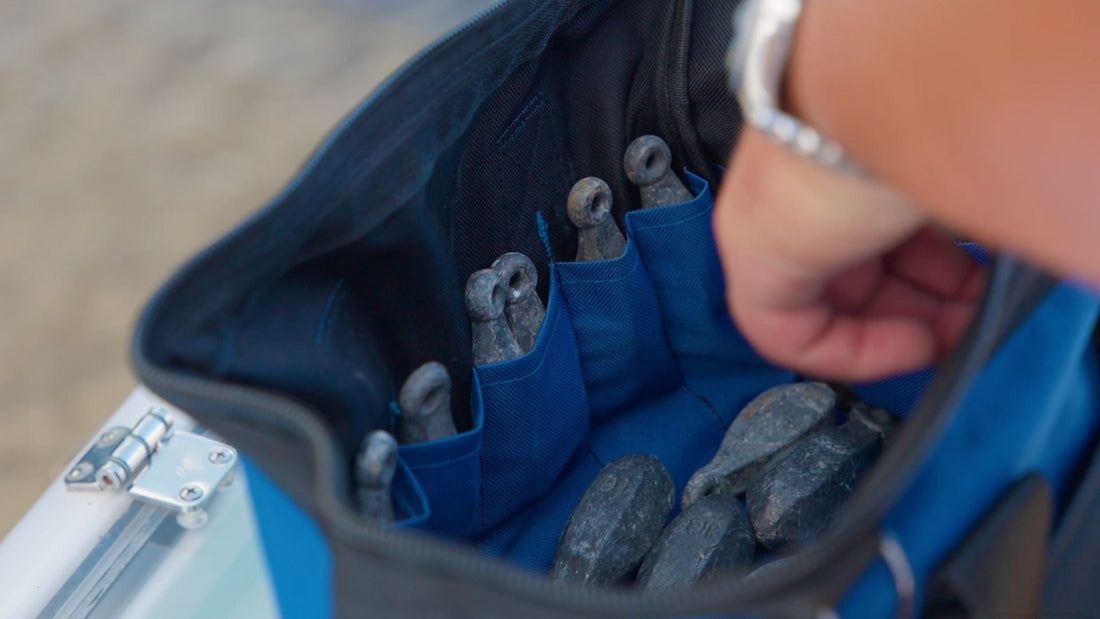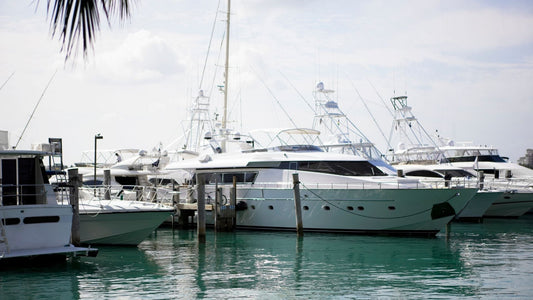
How to Store and Organize Fishing Gear on Your Boat
Nicholas HeislerShare
If you're an avid angler or a weekend fishing warrior, you already know the chaos that can unfold on a cluttered boat. Hooks catch on towels, rods get stepped on, and lures mysteriously disappear right when you need them. The good news? It doesn't have to be this way. With smart organization and the right storage tools, you can transform your boat into a well-oiled fishing machine that's efficient, safe, and ready to reel in success.
In this guide, we'll walk you through the best practices for organizing your fishing gear on a boat. We'll also highlight the new Fishing Weight Lead Bag from Captain's Preferred, a must-have for managing those heavy weights that are tough to store and carry.
Why Boat Organization Matters for Anglers
A clean, organized boat isn't just about aesthetics-it's about performance and safety.
Safety First: Fishing gear can pose serious hazards when left loose on deck. Hooks, rods, and sinkers become tripping or slipping risks, especially in rough water or when fighting a fish.
Efficiency on the Water: When your gear is organized and easy to access, you spend more time fishing and less time fumbling. That could be the difference between landing your personal best or watching it swim away while you dig through a messy tackle box.
Preservation of Gear: Saltwater, moisture, and sun exposure can degrade your gear fast if it's not stored properly. Organization on your boat helps you protect your investment.
More Space, Less Stress: Boats have limited real estate. A clutter-free deck means better movement and less stress throughout the day.
Start With a Gear Inventory
Before you can organize, you need to take stock of what you've got. You'd be surprised how many duplicate tools or half-used packs of lures you might find.
Take everything out of your compartments, boxes, and bins. Sort items into categories like:
- Rods and reels
- Tackle (lures, hooks, jigs)
- Weights and sinkers
- Lines and leaders
- Nets and gaffs
- Tools (pliers, scissors, fish grips)
- Safety gear
- Electronics and accessories
Determine what you use frequently and what can be stored seasonally. Toss out damaged or rusted items that aren't worth saving.
Designate Storage Zones on Your Boat
Once your inventory is set, the next step is to assign everything a home.
Use every inch of space wisely. Boats have more storage potential than you might think. Try the following zones:
- Under-seat compartments: Great for heavier items or tackle trays.
- Gunwale storage: Ideal for long items like gaffs or net poles.
- Vertical rod holders: Keeps rods off the floor and within reach.
- Bow/stern compartments: Good for less frequently used gear or spare tackle.
- Cabin lockers or hatches: Excellent for storing bags, dry clothes, or backup supplies.
Label containers or bins by type of gear so you can quickly find what you need in the moment.
Best Containers and Bags for Fishing Gear
Having the right storage containers makes all the difference in maintaining order on your boat.
- Waterproof bins: Perfect for keeping extra gear dry and protected from salt spray.
- Soft tackle bags: Lightweight and flexible, ideal for switching between boat and shore fishing.
- Hard tackle boxes: Offer more structure and protection for fragile lures and tools.
- Mesh bags: Great for wet gear like gloves, bait towels, or cast nets-these allow airflow to prevent mildew.
- Vacuum-sealed bags: Best for organizing soft plastics or bait with strong scents.
Choose containers with clear lids or compartments so you can see what's inside without opening them.
Storing Heavy Fishing Weights Safely and Efficiently
Heavy fishing weights are one of the trickiest things to store on a boat. They're dense, sharp-edged, and often tear through weak bags or bounce around during transport.
That's where the new Fishing Weight Lead Bag from Captain's Preferred comes in.

Product Spotlight: Fishing Weight Lead Bag
- Built to handle the load: This bag is specifically engineered to carry heavy fishing weights like pyramid sinkers, trolling weights, and lead balls without breaking down.
- Reinforced materials: Durable construction means it won't tear or stretch under pressure.
- Compact and stowable: Designed to fit easily in a boat locker, under a seat, or even in a dock box.
- Convenient carry: Equipped with rugged handles for easy loading and unloading from your vehicle to the boat.
If you've ever struggled with broken zipper pouches or clunky plastic boxes that can't handle the weight, this bag is a game-changer.
Keep it stored low and secure-heavy gear should always be stored where it won't shift or fall in rough water.
Learn more about the Fishing Weight Lead Bag
Rod and Reel Storage Solutions
Rods and reels are expensive and fragile. To avoid broken tips or tangled lines, give them a dedicated storage solution.
- Vertical rod holders: Mounted along bulkheads or the transom to keep rods upright and organized.
- Horizontal racks: Useful for cabins or under-gunwale storage.
- PVC DIY racks: An affordable option if you're handy-just make sure they're securely fastened.
- Rod tubes with foam padding: Perfect for travel or storing extra setups.
Always store rods with reels removed if space allows, and make sure drag settings are loosened to extend the life of your gear.
Organizing Tackle and Lures
Tackle organization is where most anglers start-and sometimes where they stop. But having a clear system pays off.
- Species-specific boxes: Organize your tackle based on the species you're targeting (e.g., bass, flounder, mahi).
- Color-coded trays: Helps you find what you need in different water conditions.
- Rust-resistant containers: Look for boxes with tight seals and moisture-wicking materials.
- Mini organizers: Keep terminal tackle like swivels, snaps, and beads in segmented containers or pill boxes.
Don't overpack. Bring only the tackle you expect to use for the day's conditions. Overloading your boat with unused gear just creates clutter, and that makes for more hassle.
Keeping Lines, Nets, and Other Gear Tangle-Free
Few things are more frustrating than trying to untangle line or a cast net mid-bite. A little upfront organization prevents a lot of mid-trip headaches.
- Spool boxes: Keep your extra line coiled neatly and labeled by weight and material.
- Hanging mesh bags: Perfect for storing nets, ropes, and other flexible gear while allowing them to dry.
- Velcro straps or cable ties: Use these to bundle long gear and keep it secure.
- Avoid UV exposure: Store sensitive materials like mono or fluorocarbon in dark compartments to prevent degradation.
Check for tangles before you leave the dock-not when the bite is on.
Maintenance Tips for Organized Gear
Once everything's in place, regular upkeep will keep your organization system working for the long haul.
- Rinse all gear with freshwater or a salt neutralizer after each trip, especially if you fish saltwater.
- Dry thoroughly before storing to avoid rust or mold.
- Restock weekly: Check tackle trays and replace anything used or damaged.
- Keep a gear log or checklist for seasonal items so you don't forget them next time.
- Rotate gear: Use older tackle first so nothing sits unused for seasons on end.
Organization isn't a one-time job-it's part of your fishing routine. You may consider adding some of your favorite organizational gear to your Christmas list or boater gift wishlist for gift ideas that are practical and will help keep your boat in order.
Organization is Preparation
Every angler wants to spend more time casting and less time digging through gear. A well-organized boat gives you a tactical advantage, keeps your equipment in better shape, and makes your day on the water smoother and safer.




